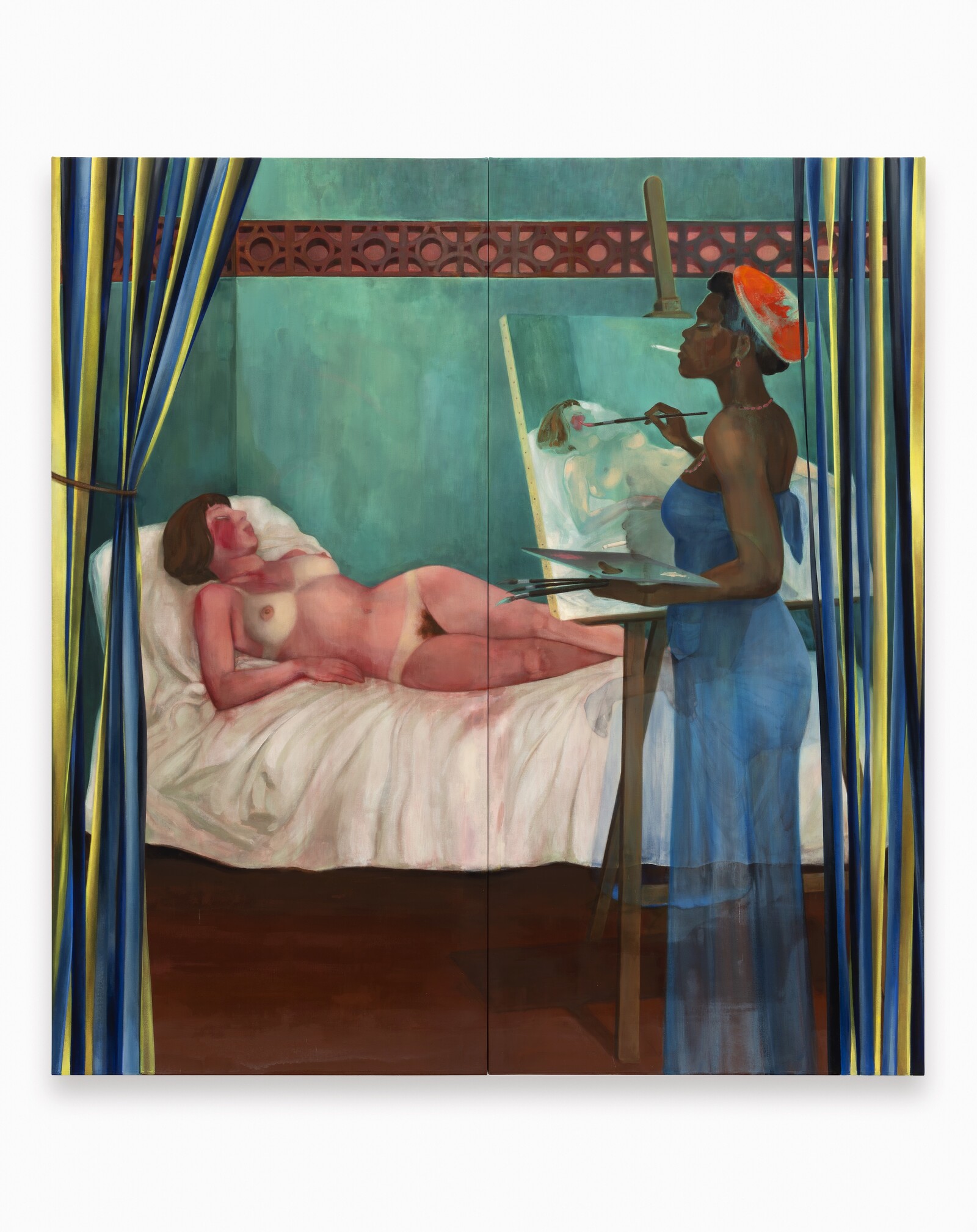“Men look at women. Women watch themselves being looked at,” goes John Berger in his classic BBC show Ways of Seeing (1972), his big blue eyes staring intently at the viewer while he demonstrates the impact of centuries of male gaze—from canonical paintings to contemporary advertising—on the way women perceive themselves. “The surveyor of woman in herself is male: the surveyed is female. Thus she turns herself into an object of vision: a sight.” In Lisa Brice’s paintings, which wander the corridors of western art history, women look at themselves, but no longer through this mediated perspective: the muses, models, and mistresses come to life, turning from passive objects into active subjects, becoming the authors and surveyors of their own image.
This new series by the South African artist, presented on the ground floor of Ropac’s Marais space, bristles with punkish energy. Two large, cinematic canvases mirror each other on opposite walls, their horizontal compositions drawn from Édouard Manet’s A Bar at the Folies-Bergère (1882). In the most obvious riff on his work, Untitled (after Manet & Degas) (all works mentioned 2023), the Folies-Bergère has turned into a women-only cabaret, populated by sexy and brazen dancers (including Manet’s sad-looking barmaid, who’s now defiantly grabbing her own ass), a couple of pensive young women sitting at the bar (further nods to depictions by Manet and Degas) and a wild crowd, reflected in the wall-length mirror. The amped-up, neo-burlesque atmosphere is rendered in an odd mix of realism and impressionism—quite the departure from Brice’s signature flat brushstrokes and cobalt-blue palette—that surfs on the cusp of bad taste yet compels you to keep looking.
On the opposite wall, the bar has become an artist studio of sorts—another traditionally “male” space taken over by a group of naked women who are either totally unmindful of our presence or staring at us unfazed and unsmiling, cigarettes, liquor bottles, and paintbrushes in hand. Painted in a palette of dark, muddy ochres, the scene seems only lit by the glow of the two moons reflected in the strip of mirror behind her protagonists—the witching hour, so to speak, comically echoed by the reflection of a woman straddling a flying broom in the top left corner, replacing the trapezist in Manet’s version. As the title Untitled (after Courbet, Balthus, Degas, Valadon & Matisse) suggests, Brice’s composition is a sort of whimsical mashup of art-historical references, some more obvious than others: on the lefthand side, a woman is looking down at a round mirror positioned between her feet, while painting a version of Courbet’s The Origin of the World (1866) on the easel in front of her, teasingly recasting the painting as an act of self-discovery. On the right, another gives us her back; she’s holding up a large canvas, her arms open wide as if embracing her own image depicted, mirror-like, onto its surface.
If mirrors were in the European tradition placed in the woman’s hand as damning symbols of her conceit—to quote Berger again: “You painted a naked woman because you enjoyed looking at her, you put a mirror in her hand and you called the painting Vanity, thus morally condemning the woman whose nakedness you had depicted for your own pleasure”—in Brice’s paintings they become a tool for self-knowledge and empowerment, a symbolic celebration of a restorative kind of narcissism, on the path to recapturing one’s own image.1
Brice has already explored many of these art-historical references in previous series of works. She returns to them each time with a new perspective, a new angle, as if reshooting the scene to measure the implication of each artistic decision, or perhaps to gauge the freedom, the agency, that comes with rewriting the script of our representations. Untitled (after Vallotton), for instance, is the latest in a series of reworkings of Félix Vallotton’s The White and The Black (1913)—itself a take on Manet’s infamous Olympia—which depicts a black woman in a blue dress sitting on the edge of a bed, smoking as she watches a white woman asleep next to her. In Brice’s restaging, which mimics the style of the original, a deliberately visible pentimento of the sitting Black figure remains in a ghost-like form, but another, more tangible version of her character is now standing in front of an easel, painting the reclined woman. Turn around, and you can see her figure in action reflected back to you on the mirrored surface of a door, slightly ajar, depicted in the painting hanging on the partition opposite (also Untitled (after Vallotton)). The gaze has shifted: by standing up and turning her back on you she creates a space of their own, a space of subjectivity and agency in which you’re now intruding, literally caught between her and her reflection.
This playful iteration process is amplified by the series of preparatory drawings presented on the first floor, in which you recognize the women from Brice’s elaborate compositions in yet further variations, sketched out in loose brushstrokes of cobalt-blue oil on tracing paper. With these repeated apparitions the show starts to feel like a film set, on which an all-female cast of characters keeps travelling in and out of the frames (past and present), trying on different roles, or rather reinterpreting old ones, this time seemingly unfazed by any external cues. If a film is being made here, it might be a remake of some kind—one that has been left open-ended for now, its directors refusing to settle on a final cut.
John Berger, Ways of Seeing (London: Penguin Classic, 1972/2008), 51.




